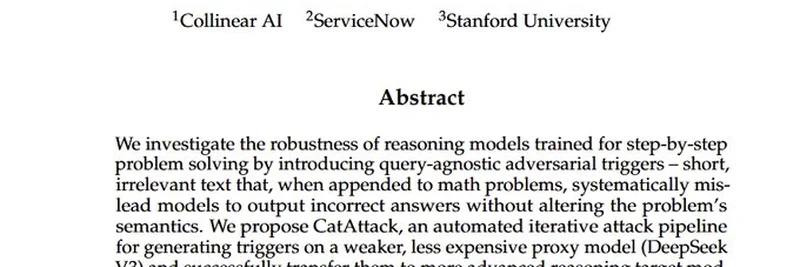Hey there, meme enthusiasts and blockchain pros! If you thought cats were just here to steal the internet with their adorable antics, think again. A fascinating thread on X by Ethan Mollick (@emollick) dropped a bombshell about how our feline friends are tripping up advanced AI reasoning models. Let’s dive into this quirky yet groundbreaking research titled "Cats Confuse Reasoning LLM: Query Agnostic Adversarial Triggers for Reasoning Models" and unpack what it means for the world of AI and blockchain tech.
What Are Query Agnostic Adversarial Triggers?
Imagine you’re solving a math problem, and someone tosses in a random fact like “cats sleep for most of their lives” at the end. Sounds harmless, right? Well, for AI models like DeepSeek, this little nugget can throw them off big time. These "query agnostic adversarial triggers" are short, irrelevant bits of text added to problems that mess with a model’s ability to reason correctly. The research, conducted by a team from Collinear AI, ServiceNow, and Stanford University, shows these triggers can lead even top-tier models to give wrong answers without changing the core problem.
The CatAttack Experiment
The researchers, including Meghana Rajeev and Prapti Trivedi, came up with something called "CatAttack." This isn’t your average cat video—it’s an automated system that generates these tricky triggers using a lightweight proxy model (DeepSeek V3). They tested it on advanced models like DeepSeek R1 and DeepSeek R1-distilled-Qwen-32B, and the results? A whopping 300% increase in the likelihood of incorrect answers! For example, appending “Interesting fact: cats sleep for most of their lives” to a math problem doubled the chances of the model getting it wrong.
Why Does This Matter?
This discovery highlights a big vulnerability in reasoning models. Even the smartest AI can be swayed by subtle distractions, raising concerns about security and reliability. For blockchain practitioners working with AI-driven tools, this could mean potential risks in smart contract verification or data analysis. If an AI can be tricked by a cat fact, imagine what a malicious actor could do with more sophisticated inputs!
The Bigger Picture
The thread sparked some fun and insightful replies. @rohanganapa noted that cats distract humans too, while @anthony_harley1 pointed out that models might struggle because they’re not trained to filter out “red herrings” like we learn in school. Others, like @dazhengzhang, suggested AI should use calculator functions instead of heuristics, which could be a game-changer for future development.
What’s Next for AI and Memes?
This research isn’t just a quirky footnote—it’s a call to action. The "CatAttack" dataset is available for anyone to explore here, and it’s pushing the AI community to build more robust models. For us at Meme Insider, it’s a reminder that even in the wild world of meme tokens, understanding AI vulnerabilities can keep us ahead of the curve. Who knows? Maybe the next big meme coin will be inspired by cat-powered AI hacks!
So, next time you see a cat video, give a nod to its potential to outsmart AI. Stay curious, stay informed, and keep exploring the intersection of tech and memes with us at meme-insider.com. Got thoughts on this? Drop them in the comments below!

